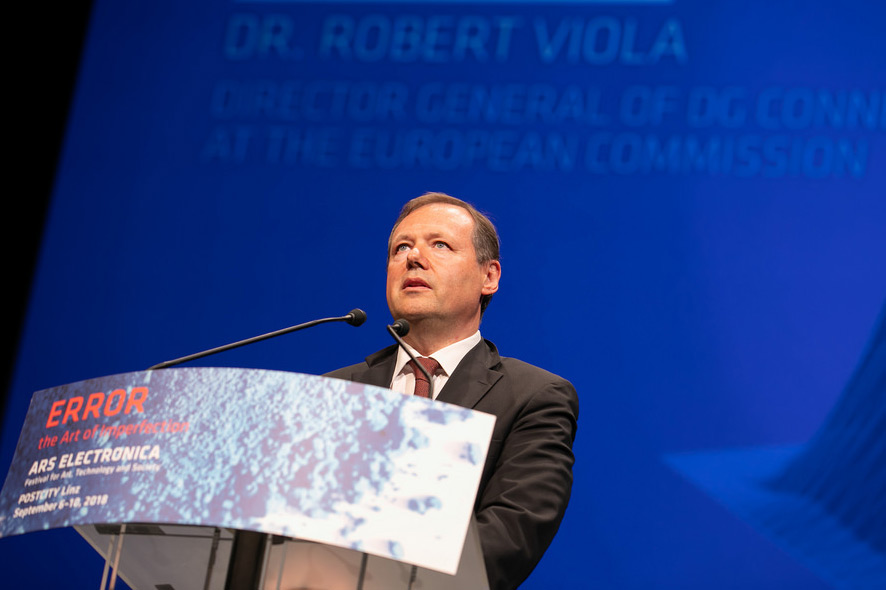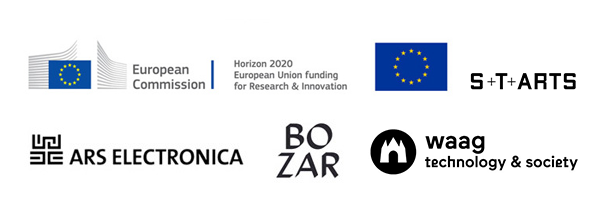by Roberto Viola
I had a chance to reflect on the future of Artificial Intelligence (AI) when I recently took part in a very interesting event in Linz – Ars Electronica – linking art, technology and society. Here are some thoughts which I would like to share also with my readers – on the input which art-science-technology collaborations can provide and on the role of the human touch in the next AI developments. Ever increasing computing power, ever more data, and ever more algorithms have turned Artificial Intelligence (AI) into a key technology for the 21st century.
The European Communication on AI has laid out an ambitious plan to place Europe at the forefront of future AI. AI is everywhere. AI is in online search, in future self-driving cars, in speech recognition of IPhone’s SIRI, in face recognition of surveillance systems, in today’s advanced robots and so on. All these opportunities from AI are mitigated by various risks: e.g. loss of privacy and surveillance of citizens due to the data hunger of these technologies.
Towards an AI “made in Europe” with a human touch
One of the key challenges for future AI will be what I like to call ‘the human challenge’. How will AI and humans work together? How can AI serve humans best? This will become a major issue in our efforts to promote AI as the next major technology of the future. A differentiating factor for an AI ‘made in Europe’ will be its human touch: a focus on the human dimension, an insistence that AI serves human needs: AI must enhance human capacity, not replace humans! Ars Electronica anticipated such discussions! The 2017 festival theme ‘Artificial Intelligence: ‘The Other I’ pointed to the capacity of AI to learn independently and become an autonomous ‘other I’.
The role of Arts for an AI with a human touch
The 2017 festival theme also pointed to the arts to help address this human challenge for AI. The role of the Arts will be decisive: Artists bring a human perspective to AI. By tapping into creativity of artists, Europe will lead the way towards human-centred AI. But what are these special qualities of artists that make them so crucial in our current technology-oriented society?
“I think, artists approach technology in a twofold way: They play with and explore technologies and they keep a critical eye on their potential drawbacks and limits. Technology serves artists as medium and, in turn, artists shape it.”
Crucially, artists help citizens in developing critical thinking about technology! Think of Social Media where artists have reflected since a long time on privacy and surveillance, on how to avoid a 1984 Orwell scenario! Long before Cambridge Analytica became a household name!
How art and technology interact: example from music
So how can art and technology engage in mutually fruitful exchanges? How can artists shape technology? Do they want to shape technology?
Allow me to give an example on music and technology triggered by my own interest in music to exemplify what I mean. Technology has always influenced the development of music – think of the pianoforte that revolutionised music performances and ultimately composition around 1700. Today, AI – neural networks – can be trained to compose music to ‘reinvent Bach’ or to come up with new types of music. One of the today’s panellists is working on software that will create personalised music. Bach of course is in many ways very formalised. Would computers as easily reproduce music of say Eric Satie? And who is the creator? The algorithms? The programmer?
“The key here is ‘creativity’ and its link to what it means to be human: Art is at the heart of this debate. This is why, in my opinion, synergies between the Arts and technology will be crucial for our attempts to create an AI with a human touch.”
These are preliminary reflections. I now want to present briefly the programme that we developed in the European Commission to respond to such reflections.

The STARTS programme
Commissioner Oettinger sensed the need for synergies between art and technology very early. He expressed the idea succinctly: ‘In the digital age, engineering and art are no longer contradictory modes of thinking’. With these issues in mind, we have developed the S+T+ARTS = STARTS program combining the best thinking of the three worlds – Science, Technology and the ARTS. We are funding projects in STARTS since last year. We will invest a total of 17MEUR in activities in four main STARTS pillars via the H2020 funding programme:
- STARTS Prize gives visibility to successful collaborations between art and technology. I am in Linz to hand out the STARTS prizes tonight at the gala event to its two winners.
- STARTS Residencies fund longer term stays of artists in technology institutions. They allow artists and engineers to better know each and work in concrete settings.
- In STARTS Academies artists and engineers jointly teach digital skills to citizens.
- STARTS Lighthouse pilots are technology projects that demand that artists are integrated in research teams attempting to achieve concrete and ambitious goals. The first two lighthouse pilots will start in 2019.
Conclusion
The expectation is that teams of artists and researchers will develop better and more human-centred technologies. This could be particularly true for AI. Europe is well placed in the world-wide race towards future AI systems and applications. Its artistic and cultural potential will be of great help. The willingness of the art world to contribute to the debate on future technologies is confirmed by a series of STARTS workshops organised with ‘la Biennale di Venezia’, V&A in London, BOZAR in Brussels, Guggenheim in Bilbao and not the least by the prominence of STARTS in this year’s Ars Electronica Festival. I am therefore sure that we will be able to combine our strength in science and technology with our unique assets in culture and the arts to give AI a distinctive European human touch.
Read the original article by Roberto Viola that was published on the “Digital Single Market Blog” of the European Commission on :
https://ec.europa.eu/digital-single-market/en/blogposts/artificial-intelligence-next-frontier

Roberto Viola is Director General of DG CONNECT (Directorate General of Communication, Networks, Content and Technology) at the European Commission. Before joining the EC, he held the position of Secretary General of AGCOM and various other positions including as Head of Telecommunication and Broadcasting Satellite Services at ESA. He served as Chairman of the European Radio Spectrum Policy group (RSPG). Roberto Viola holds a Doctorate in Electronic Engineering and a MBA.
This project has received funding from the European Union’s Horizon 2020 research and innovation programme under grant agreement No 732019. This publication (communication) reflects the views only of the author, and the European Commission cannot be held responsible for any use which may be made of the information contained therei
